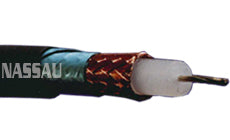Product Details
This is a low smoke radio frequency wire used in marine shipboards. It is designed to hold out against the extreme and challenging conditions exhibited with marine environments. Cables and wires meant for marine application should be able to resist elements such as corrosion, salt, high moisture content, and mechanical damage. The shipboard cables should also be easy to install meaning they peel and bend easily. they should be waterproof, light, and small. MIL-DTL-17 and Navsea Triaxial wires have low smoke remittance.
Applications
• For use in operations within temperatures -30°C to 85°C
• Designed for use on naval shipboard
• These wire cables may be used in installation for radio frequency demanding low smoke release. They have found usage in naval or military shipboards. They may also be used in aerospace applications including radar systems, ground support equipment, flight guidance equipment, and secure communications because of their reliability and versatility.
Insulation, jacketing, and shield
• Insulation : Polyethylene
• Jacket : cross-linked polyolefin
• Shield : tape and braid
• An insulation material made of polyethylene is used on the wires. Polyethylene abbreviated as PE is a compound that is mostly used in low capacitance cables and in coaxial cables because it has excellent electric qualities. Most of the times, PE is used in such applications since it’s affordable and may be foamed to allow it have a lower dielectric constant of about 1.5. This makes it an ideal choice for cables that require high speed transmission. The jacket is made of cross-linked polyolefin, which offers exemplary fire resistance, UV resistance, and chemical resistance. Cross-linkedpolyolefin (XLPO) is halogen free and doesn’t release noxious gases in exposure to elements such as fire and flame. In addition, a shield made of tape and braid is used to offer more protection against environmental and mechanical damage while strengthening the cables. These cables also have excellent abrasion resistance.
US Navy Requirements
• Smoke Index: 25
• Toxicity Index: 5 Max.
• Acid Gas Generation: 2.0% Max.
• Halogen Content: .2% Max.
| conductor awg stranding & material |
low smoke equiva- lent |
continuous working voltage v rms |
rscc defense part number |
Action |
| 18 7/26 tc | rg11 | 3700 | mil-dtl17/181-18 | Request A Quote |
| 20 19/.0071 tc | rg11 | 1400 | mil-dtl17/183-20 | Request A Quote |
| 23 solid cu steel | rg11 | 1700 | mil-dtl17/184-23 | Request A Quote |
| 22 solid cu steel | rg11 | 750 | mil-dtl17/185-22 | Request A Quote |
| 12 7/.0296 bc | - | 3700 | mil-dtl17/189-12 | Request A Quote |
| 12 7/.0296 sc | - | 3700 | mil-dtl17/190-12 | Request A Quote |
| 18 7/26 tc | - | 3700 | mil-dtl17/191-18 | Request A Quote |
| 19 solid sc | - | 1400 | mil-dtl17/194-19 | Request A Quote |
| 26 7/34 cu steel | rg11 | 1100 | mil-dtl17/196-26 | Request A Quote |
| cancelled, refer to mil-dtl-17/183 | mil-dtl17/197 | |||
| 12 7/.0296 bc | rg11 | 3700 | mil-dtl17/213-12 | Request A Quote |
| 12 7/.0296 sc | - | 3700 | mil-dtl17/214-12 | Request A Quote |
| 26 7/34 cu steel | rg11 | 1100 | mil-dtl17/217-26 | Request A Quote |
| 12 7/20 sc | - | 2000 | ns6262065-1 | Request A Quote |
| 18 19/30 tc | - | 2000 | ns6322493 | Request A Quote |

